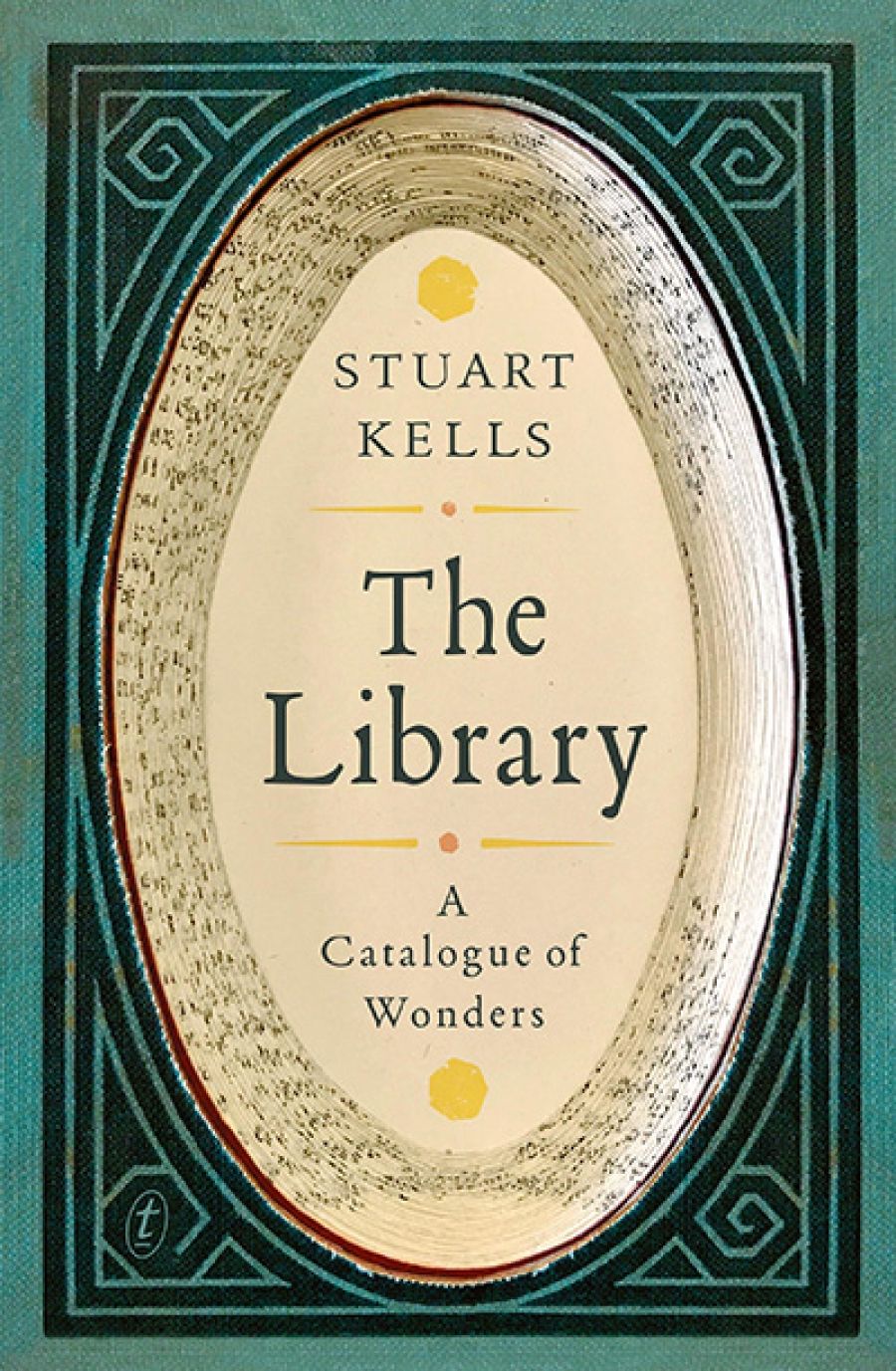
- Free Article: No
- Contents Category: Literary Studies
- Custom Article Title: Des Cowley reviews 'The Library: A catalogue of wonders' by Stuart Kells
- Custom Highlight Text:
In 2002, journalist Guy Rundle published a piece devoted to the little-known visit by Argentinian writer Jorge Luis Borges to Melbourne in May 1938. During his ten-day stay, Borges spent time in the domed reading room of the State Library, a place he found ‘awe-inspiring, even overwhelming’. As a long-term reader of Borges ...
- Book 1 Title: The Library
- Book 1 Subtitle: A catalogue of wonders
- Book 1 Biblio: Text Publishing, $32.99 pb, 278 pp, 9781925355994
Stuart Kells begins his account of libraries with a description of Borges’s infinite library, signalling his intention, from the outset, to engage not just with the real and documented, but with the imaginary and the apocryphal. Libraries, after all, are spaces for contemplation and dreams, a role cemented in our collective imagination via countless works of literature and film. Accordingly, Kells finds space in his book for the Pierpont Morgan Library in New York and for the Middle-earth library of Bilbo Baggins.
While we tend to think of libraries as collections of books on shelves, Kells reminds us that the earliest libraries were made up of oral stories and legends that pre-date the earliest books. The dream of gathering the world’s knowledge in a physical location would come later, with libraries such as the one at Alexandria, in Egypt, housing countless papyrus scrolls. Its destruction by fire would find later echo in books such as Ray Bradbury’s Fahrenheit 451 (1953)and Elias Canetti’s Auto-da-Fé (1935), tapping into our deep-seated abhorrence of book burning. The arrival of the codex, with its parchment pages, around 100 CE set the scene for Europe’s great monastic libraries of the Middle Ages, with their scribes and illuminators, so elaborately – and, according to medievalists, exaggeratedly – imagined by Umberto Eco in The Name of the Rose (1980).
The subtitle of Kells’s book, ‘A Catalogue of Wonders’, foreshadows the author’s interests. The history of books and libraries has thrown up more than its fair share of eccentric and dubious characters, and Kells is clearly drawn to this decidedly murky world. Take the case of Gian Francesco Poggio Bracciolini, who visited many monasteries in the fifteenth century, including the one at St Gall, ‘rescuing’ books from libraries that had fallen into disrepair. While Poggio’s actions might be construed as theft, there can be little doubt that many significant works of Greek and Roman literature were salvaged by such means. No such altruistic motives can be assigned to eighteenth-century Florentine collector Count Guglielmo Libri, whose title and connections provided him with access to the finest collections in Europe. A notorious book thief, he was especially adept at creating false provenances, adding new shelf marks and bindings to obscure his tracks.
 Folger Shakespeare Library, Washington (Wikimedia Commons)
Folger Shakespeare Library, Washington (Wikimedia Commons)
Kells proves a generous guide, taking us on a whirlwind tour through several thousand years of book history. He does, however, adopt a more leisurely pace when it comes to recounting the history of some of the world’s great libraries, including the Vatican Library, the Pierpont Morgan Library, and the Folger Shakespeare Library in Washington. The Folger, in particular, raises the question of how many copies of a book are enough. Once accused of monopolising Shakespeare Folios, the Folger today allows scholars the opportunity to make detailed comparative studies, thereby facilitating new textual discoveries. Compare that to the John Rylands Library in Manchester, which in the 1970s sold off ninety-eight rare ‘duplicates’, many later identified as possessing unique features. Book historian Nicholas Barker likened the Rylands sale to ‘pillaging a trilith from Stonehenge’.
The time-honoured profession of librarian is given its due in a chapter on the best and worst in history. The best, such as seventeenth-century Gabriel Naudé and Anthony Panizzi, of the British Museum, revolutionised the approach to library collecting and design. Despite their consolidations, however, the history of books and libraries abounds with loss and destruction. The Great Fire of London, in 1666, eradicated a good portion of Shakespeare’s Third Folio (1663), today rarer than the First (1623), while untold wars have led to irretrievable losses of library collections and cultural heritage.
While Kells draws heavily on earlier sources, and arguably overemphasises the Western tradition of libraries, his book nonetheless comprises a fascinating compendium of facts and stories relating to the history of books and libraries. Clearly aimed at a wide readership, it is more closely aligned with works such as Henry Petroski’s The Book on the Bookshelf (1999), Alberto Manguel’s The Library at Night (2006), and Lucien X. Polastron’s Books on Fire (2007) than with Konstantinos Staikos’s somewhat forbidding six-volume The History of the Library in Western Civilization (2004–13).
In late 2015, Alberto Manguel was appointed director of the National Library in Buenos Aires, following in the footsteps of his master, Jorge Luis Borges. On a visit to Melbourne earlier this year, he spent time in the State Library. As he circled the Domed Reading Room, viewing the rare books on display there, he lamented the lack of books on public display in his own library, something he intended to redress. I could only concur. For what, after all, is a library without books?


Comments powered by CComment